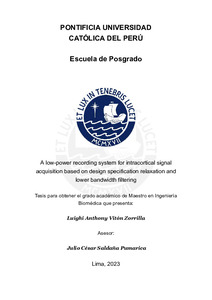| dc.contributor.advisor | Saldaña Pumarica, Julio César | |
| dc.contributor.author | Vitón Zorrilla, Luighi Anthony | |
| dc.date.accessioned | 2024-01-19T15:54:55Z | |
| dc.date.available | 2024-01-19T15:54:55Z | |
| dc.date.created | 2023 | |
| dc.date.issued | 2024-01-19 | |
| dc.identifier.uri | http://hdl.handle.net/20.500.12404/26838 | |
| dc.description.abstract | In this thesis, we designed and evaluated a circuit model at the transistor level of a
low-resolution and low bandwidth ADC (analog-to-digital converter) with level-crossing
architecture (LCADC), used as part of the acquisition chain of a BCI (brain-to-computer
interface) device. The aim is to obtain minimal specifications that could return adequate
levels of accuracy at spike detection and reduce power dissipation. In addition, we included
a NEO preprocessor in the test to help in the detection accuracy. To achieve the
objectives proposed, we started developing a software model for the preprocessor and the
ADCs to evaluate the different variations of resolution, bandwidth, noise level, and NEO
window. After finding the desired minimum values, we continued with the hardware development
of the ADC. We designed the level crossing architecture and a conventional
SAR to have a reference against which we compare the LCADC performance. After that,
we developed a NEO circuit and applied synthesized neural recordings to evaluate power
consumption with the ADC. Additionally, we designed a conventional analog frontend to
estimate the power for the band of interest. Also, we estimated the dissipation for wireless
transmission by calculating the approximated data stream expected in the level-crossing
sampling scheme. Summing them, we obtained the power consumption of the complete
acquisition chain. In conclusion, although reducing the intrinsic power of the LCADC is
challenging, the scheme helps reduce the total power consumption of the acquisition chain
with adequate accuracy, making it competitive against currently reported BCI devices. | es_ES |
| dc.description.abstract | En esta tesis se ha diseñado y evaluado un circuito a nivel de transistores de un ADC
(conversor analógico-digital) de baja resolución y ancho de banda reducido con arquitectura
de cruce de nivel (LCADC), utilizado como parte de la cadena de adquisición de un
dispositivo BCI (interfaz cerebro-computadora). El objetivo es obtener especificaciones
mínimas que puedan devolver niveles adecuados de precisión en la detección de picos y
reducir la disipación de energía. Además, se incluyó un preprocesador NEO en la evaluación
para ayudar en la precisión de la detección. Para lograr los objetivos propuestos, se
desarrolló un modelo de software del preprocesador y los ADCs a fin de evaluar las diferentes
variaciones de resolución, ancho de banda, nivel de ruido y ventana del NEO. Luego
de encontrar los valores mínimos deseados, se continuó con el desarrollo de hardware del
ADC. Se diseñó la arquitectura de cruce de nivel y un SAR convencional para tener una
referencia con la cual comparar el rendimiento del LCADC. Después de eso, se desarrolló
un circuito NEO y se aplicó las señales neuronales sintetizadas para evaluar el consumo de
energía con el ADC. También, se diseñó una interfaz analógica convencional para estimar
la potencia de la banda de interés. Así mismo, se estimó la disipación de la transmisión
inalámbrica calculando el flujo de datos aproximado esperado en el esquema de muestreo
de cruce de nivel. Finalmente, sumando los resultados se obtuvo el consumo de energía de
la cadena de adquisición completa. A partir de estos, se concluye que aunque reducir la
potencia intrínseca del LCADC es un desafío, el esquema ayuda a disminuir el consumo
total de energía de la cadena de adquisición con una precisión adecuada; lo cual lo hace
competitivo frente a otros dispositivos BCI reportados actualmente. | es_ES |
| dc.language.iso | eng | es_ES |
| dc.publisher | Pontificia Universidad Católica del Perú | es_ES |
| dc.rights | info:eu-repo/semantics/openAccess | es_ES |
| dc.rights.uri | http://creativecommons.org/licenses/by-sa/2.5/pe/ | * |
| dc.subject | Interfaces de usuarios (Computación) | es_ES |
| dc.subject | Procesamiento de señales biomédicas | es_ES |
| dc.subject | Redes neuronales (Computación) | es_ES |
| dc.title | A lowpower recording system for intracortical signal acquisition based on design specification relaxation and lower bandwidth filtering | es_ES |
| dc.type | info:eu-repo/semantics/masterThesis | es_ES |
| thesis.degree.name | Maestro en Ingeniería Biomédica | es_ES |
| thesis.degree.level | Maestría | es_ES |
| thesis.degree.grantor | Pontificia Universidad Católica del Perú. Escuela de Posgrado. | es_ES |
| thesis.degree.discipline | Ingeniería Biomédica | es_ES |
| renati.advisor.dni | 10123705 | |
| renati.advisor.orcid | https://orcid.org/0000-0001-6834-6436 | es_ES |
| renati.author.dni | 76538784 | |
| renati.discipline | 919277 | es_ES |
| renati.juror | Silva Cardenas, Carlos Bernardino | es_ES |
| renati.juror | Saldaña Pumarica, Julio Cesar | es_ES |
| renati.juror | Monge Osorio, Manuel Alejandro | es_ES |
| renati.level | https://purl.org/pe-repo/renati/level#maestro | es_ES |
| renati.type | https://purl.org/pe-repo/renati/type#tesis | es_ES |
| dc.publisher.country | PE | es_ES |
| dc.subject.ocde | https://purl.org/pe-repo/ocde/ford#2.00.00 | es_ES |







